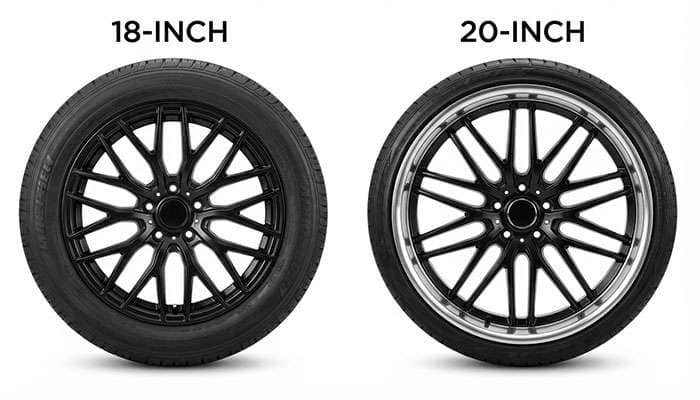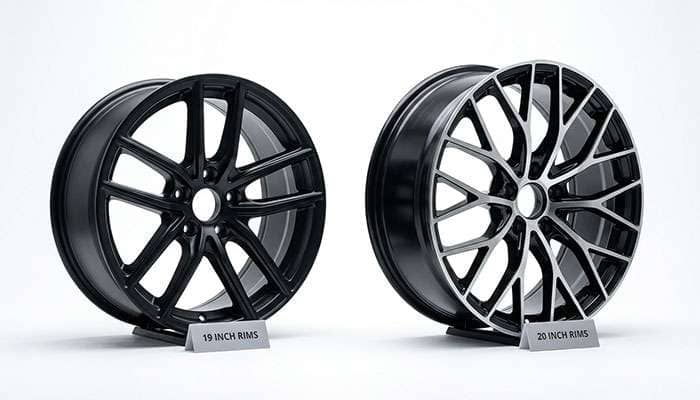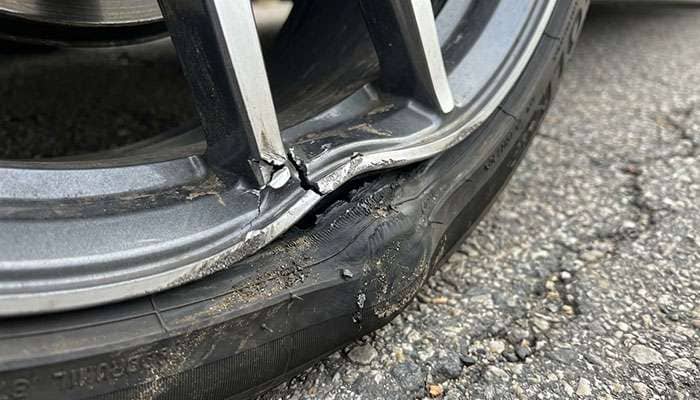
Custom wheels are a popular choice for drivers looking to upgrade their vehicle's performance and appearance. When it comes to 20-inch wheels, the benefits extend far beyond just looking good. According to Consumer Reports, plus-sizing your tires to 20 inches delivers noticeable performance improvements, specifically better handling and cornering capabilities. The larger diameter creates a broader tire contact patch with the road, providing superior grip and more responsive steering.
The visual impact of 20-inch wheels makes them stand out from smaller options. These larger wheels showcase more of the rim design while reducing tire sidewall, creating an aggressive and stylish appearance that transforms your vehicle's stance. However, understanding the complete picture matters before making this upgrade. The increased size and weight mean your engine works harder during acceleration. You'll also experience more road impact when driving over potholes, speed bumps, or rough surfaces due to the reduced sidewall cushioning.
We believe in providing you with all the facts before you make this significant investment. This guide covers everything you need to know about 20-inch wheels - from performance benefits to potential drawbacks - helping you determine if they're the right choice for your specific driving needs and vehicle.

Understanding wheel upgrades means more than just bolting on larger rims. This modification follows specific engineering principles designed to maintain your vehicle's performance characteristics while enhancing particular aspects of handling and appearance.
Plus-sizing increases your wheel diameter while keeping the overall tire diameter nearly identical. When moving from 18-inch to 20-inch wheels, you're performing what's called a "plus two" upgrade. This process requires three specific changes:
Increasing section width (typically by 20mm)
Decreasing aspect ratio (typically by 20 points)
Increasing rim diameter by 2 inches
The goal is maintaining the total wheel-and-tire combination at approximately the same outer diameter as your original equipment. This preserves your vehicle's gearing, acceleration characteristics, and the accuracy of onboard systems.
Larger wheels create the most noticeable change in tire sidewall height. Since overall diameter stays consistent, bigger wheels mean shorter sidewalls. This reduction creates a more solid connection between your rim and the road surface.
With 20-inch wheels, tire profiles typically show aspect ratios around 35-40, compared to 50-60 on smaller wheels. This shorter sidewall height dramatically affects how your vehicle responds to road conditions. The reduced flexibility delivers more immediate and precise steering response but provides less cushioning over rough surfaces.
Proper plus-sizing shouldn't affect your speedometer accuracy or vehicle systems. When the overall tire diameter remains within 3% of original equipment (OE) specifications, your speedometer continues reading correctly.
However, if your new setup's overall diameter differs by more than 3-5%, your speedometer becomes inaccurate. A larger-than-stock diameter means fewer tire rotations per mile, causing your speedometer to read slower than your actual speed.
Significant changes can affect advanced driver assistance systems (ADAS), anti-lock braking systems (ABS), and electronic stability controls that rely on accurate wheel speed data. That's why following manufacturer guidelines or working with professionals who understand proper plus-sizing calculations becomes critical for maintaining vehicle safety systems.

The performance advantages of 20-inch wheels make them a compelling upgrade for drivers who want both style and substance. These larger wheels deliver several key benefits that can transform how your vehicle handles and looks.
Twenty-inch wheels provide superior handling through increased road contact. The wider tires that typically pair with these larger wheels create a broader contact patch, dramatically improving grip during cornering. This enhanced road contact becomes especially noticeable in dry conditions, where 20-inch setups excel at maintaining stability through turns.
The physics work in your favor with larger wheels. Reduced body roll becomes immediately apparent in most vehicles. As one F-150 owner noted, "Having less sidewall definitely helps the handling by reducing body roll". This stability proves particularly valuable during spirited driving, where the difference between 18-inch and 20-inch wheels becomes most apparent.
When cornering, 20-inch wheels create a more connected feeling between your vehicle and the road. This improved connection builds confidence when navigating sharp turns or making quick lane changes - essential for both safety and driving enjoyment.
The enhanced steering response stands out as the most immediately noticeable benefit of upgrading to 20-inch wheels. Reduced sidewall height means less flex, resulting in more direct steering inputs. When you turn the wheel, your vehicle responds more promptly and predictably.
This quicker steering response comes from replacing flexible rubber sidewall with rigid metal. Test drivers consistently report "improved steering feel" and "big improvement in steering response" when moving to larger wheel setups.
For drivers who enjoy an engaged driving experience, this characteristic makes 20-inch wheels particularly appealing. The more direct connection between steering input and vehicle response creates a sportier feel that many enthusiasts prefer.
The aesthetic transformation that comes with 20-inch wheels is dramatic. Larger rims showcase intricate spoke designs and finishes that get lost with smaller wheels. The reduced tire sidewall means more of the wheel itself is visible, allowing custom finishes - whether chrome, matte black, or machined aluminum - to become focal points of your vehicle's appearance.
This visual upgrade creates an aggressive, performance-oriented stance that completely changes your vehicle's profile. The larger wheels fill out wheel wells more completely, eliminating the gap that can make stock wheels look undersized. Performance-oriented vehicles especially benefit from this appearance upgrade, as the larger wheels match the visual expectations of a high-performance machine.
Beyond personal satisfaction, this enhanced appearance can positively impact resale value. Many buyers specifically seek vehicles with upgraded wheels, viewing them as a sign of an owner who invested in their vehicle's maintenance and appearance.

While 20-inch wheels offer compelling benefits, they come with significant drawbacks that affect daily driving comfort, your wallet, and long-term vehicle maintenance. Understanding these trade-offs helps you make a realistic decision about whether the upgrade makes sense for your situation.
The shorter sidewalls that give 20-inch wheels their responsive handling become a liability on anything but perfectly smooth pavement. With less rubber to absorb impacts, every bump, pothole, and road imperfection transmits directly through to your vehicle's chassis and into the cabin.
This harshness becomes especially noticeable during daily commuting. Roads with cracks, expansion joints, or poor maintenance turn your ride noticeably rougher. Many drivers report feeling "every single pebble" when upgrading from 18-inch to 20-inch wheels. The difference is stark enough that some owners ultimately revert to smaller wheels after experiencing the constant jarring on their typical routes.
The comfort penalty isn't theoretical - it affects passenger experience and driver fatigue on longer trips. If your daily drive includes rough city streets, patched pavement, or rural roads, this single factor might outweigh all the performance benefits 20-inch wheels provide.
The reduced sidewall protection makes your expensive 20-inch wheels far more vulnerable to damage. With less rubber cushioning between the road and your rim, hitting potholes or curbs can easily bend or crack the wheel itself.
Tire manufacturers specifically warn that low-profile tires offer "far less forgiveness" when encountering road hazards. What might cause minor tire bulging with an 18-inch setup can result in a destroyed rim with 20-inch wheels. Repairing or replacing damaged 20-inch wheels costs significantly more than smaller alternatives - individual wheels often run $250-$500 or more.
This vulnerability extends to tire damage as well. The thin sidewalls are more prone to punctures, sidewall cuts, and impact damage. If you live in an area with poor road conditions or frequent construction zones, you'll likely replace tires more often than with smaller wheel sizes.
The financial commitment to 20-inch wheels extends far beyond the initial purchase. Replacement tires command premium prices - expect $220-$260 per tire compared to $180-$220 for 19-inch equivalents. Over the life of your vehicle, this price difference adds up to hundreds or thousands of dollars.
Wheel and tire packages for 20-inch setups typically run $1,400-$1,900 for a complete set. When damage occurs - and it's more likely with larger wheels - individual replacement wheels start at $250 and quickly escalate based on design and finish.
Specialty shops and dealerships also charge more for mounting, balancing, and tire installation on 20-inch wheels. The larger size requires more careful handling and specialized equipment. Some tire shops even charge premium labor rates for low-profile tire installations due to the increased difficulty and risk.
The added weight of larger wheels and tires forces your engine to work harder, directly impacting fuel efficiency. Real-world testing shows vehicles with 19-inch wheels can be up to 7% more efficient than identical models with 20-inch wheels.
This efficiency loss comes from two factors: the increased rotational mass requires more energy to accelerate, and the wider tires create additional rolling resistance. While 1-2 MPG might seem insignificant, over thousands of miles this translates to meaningful fuel cost increases.
For trucks and SUVs already struggling with lower fuel economy, this penalty becomes even more noticeable. A vehicle averaging 20 MPG that drops to 18 MPG with 20-inch wheels means 11% more trips to the gas station and higher annual fuel costs.

Making an informed wheel upgrade decision requires evaluating several factors to ensure you get the right performance characteristics. Here's how to make the best decision for your situation.
The performance differences between these sizes are significant. 20-inch wheels deliver sharper turn-in response and improved cornering stability at high speeds. However, 18-inch wheels provide noticeably better ride comfort, absorbing road imperfections more effectively. When it comes to fuel efficiency, smaller wheels have a clear advantage—tests show vehicles with 19-inch wheels can be up to 7% more efficient than identical models with 20-inch wheels. For daily driving on mixed road surfaces, 18-inch setups typically offer the better balance of comfort and performance.
Your typical driving environment should guide your wheel choice. Frequent travel on rough roads or areas with potholes makes the shorter sidewalls of 20-inch tires a liability, offering considerably less rim protection. Drivers who prioritize comfort on long trips will find 18-inch wheels the better choice. Those who enjoy spirited driving through corners and switchbacks will appreciate how 20-inch wheels reduce body roll and improve steering precision. Winter driving also favors 18-inch tires, which perform better on icy roads thanks to greater sidewall flexibility.
Your owner's manual contains critical information before making any wheel changes. Vehicle manufacturers engineer suspensions, braking systems, and electronic controls around specific wheel and tire combinations. Deviating from these specifications can negatively impact speedometer accuracy, advanced driver assistance systems, and overall vehicle dynamics. Some vehicles can accommodate upgrades from 17 or 18 to 20-inch wheels, but this depends entirely on your specific vehicle's design tolerances.
The upfront cost represents just the beginning of your investment. A complete set of 20-inch wheels typically runs between $1,400 and $1,900, with individual replacement wheels costing $250 or more. Tires for larger wheels command premium prices—expect to pay $220-$260 per tire compared to $180-$220 for 19-inch equivalents. The reduced sidewall height also increases vulnerability to damage, potentially leading to more frequent replacements. Browse quality options at Performance Plus Tire's 20-inch wheel collection to find durable choices that balance style with practical considerations.
Selecting the right wheel size comes down to matching your specific needs with the right product. 20-inch wheels deliver aggressive styling and showcase custom rim designs beautifully, but they require careful consideration of your driving priorities and road conditions.
Your typical driving environment should guide this decision. Smooth highways and city streets work perfectly with larger wheels, while rough rural roads with frequent potholes make smaller wheels the smarter choice. Performance-focused drivers will love the precise handling, but daily commuters prioritizing comfort may find the trade-offs disappointing.
We know the financial impact extends beyond the initial purchase. Replacement tires and potential rim damage cost significantly more with 20-inch setups compared to smaller wheels. That's why it's important to evaluate your long-term budget alongside your immediate wants.
At Performance Plus Tire, we've helped thousands of customers make this decision. Check out our extensive selection at Performance Plus Tire's 20-inch wheel collection to find options that balance style with your practical requirements. Our expert team can guide you through the fitment process and help you understand how different wheel sizes will affect your specific vehicle.
The key is being honest about your priorities. Manufacturer specifications exist for important safety and performance reasons. Whether you choose to upgrade or stay with factory size, understanding these factors ensures you'll be satisfied with your decision for years to come.
Ready to explore your options? Our knowledgeable staff is here to help you find the perfect wheels that match both your vision and your driving needs.
Before upgrading to 20-inch wheels, understand both the performance benefits and practical drawbacks to make an informed decision that matches your driving needs and budget.
• 20-inch wheels improve handling and steering response but sacrifice ride comfort due to reduced tire sidewall cushioning • Higher costs extend beyond purchase price - expect $200-500 per replacement wheel and premium tire prices throughout ownership • Road conditions should guide your choice - smooth highways favor larger wheels while rough roads make smaller wheels more practical • Manufacturer specifications matter for safety - straying too far from original equipment can affect speedometer accuracy and vehicle systems • Consider your driving priorities - performance enthusiasts benefit from precise handling while comfort-focused drivers prefer smaller wheels
The decision between 18-inch and 20-inch wheels ultimately depends on whether you prioritize aggressive styling and sharp handling over ride comfort and long-term costs. Always consult your owner's manual and consider your typical driving environment before making this significant upgrade.
20-inch wheels generally improve handling and cornering due to their larger contact patch with the road. They provide better grip and more responsive steering, especially during high-speed maneuvers and sharp turns.
The main drawbacks include reduced ride comfort on rough roads, higher risk of rim and tire damage, increased replacement and maintenance costs, and potential negative impacts on fuel economy due to the added weight.
Yes, 20-inch wheels can negatively impact fuel efficiency. The added weight requires more energy to move, which can result in reduced fuel economy. Some drivers report losing 1-2 MPG after upgrading to 20-inch wheels.
20-inch wheels are best suited for smooth roads and performance driving. They may not be ideal for rough terrain, areas with frequent potholes, or winter driving conditions where more tire sidewall flexibility is beneficial.
20-inch wheels and tires are generally more expensive than smaller sizes. A set of 20-inch wheels typically costs between $1,400 and $1,900, with individual replacement wheels running $250 or more. Tires for these larger wheels also command premium prices, often $220-$260 per tire compared to $180-$220 for 19-inch equivalents.